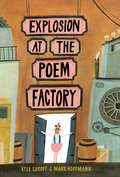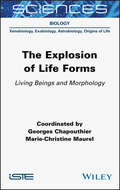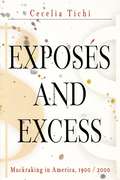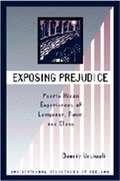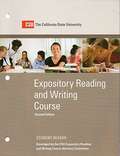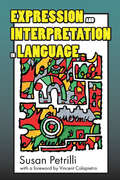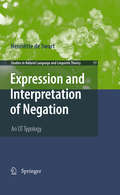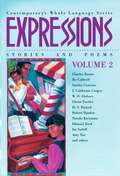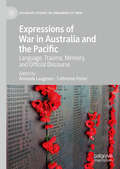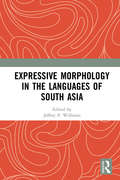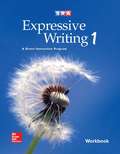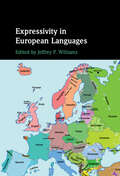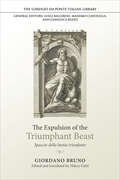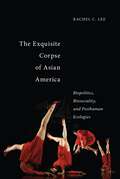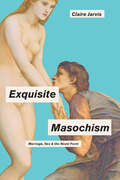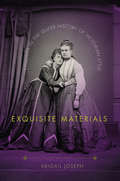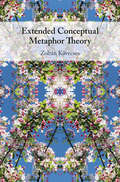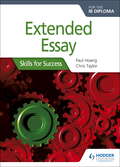- Table View
- List View
Explosion at the Poem Factory
by Kyle LukoffA funny story, full of wordplay, brings poetry alive as never before! Kilmer Watts makes his living teaching piano lessons, but when automatic pianos arrive in town, he realizes he’s out of a job. He spots a “Help Wanted” sign at the poem factory and decides to investigate — he’s always been curious about how poems are made. The foreman explains that machines and assembly lines are used for poetry these days. So Kilmer learns how to operate the “meter meter” and empty the “cliché bins.” He assembles a poem by picking out a rhyme scheme, sprinkling in some similes and adding alliteration. But one day the machines malfunction, and there is a dramatic explosion at the poem factory. How will poetry ever survive? Kyle Lukoff’s funny story, rich in wordplay, is complemented by Mark Hoffmann’s lively, quirky art. The backmatter includes definitions of poetic feet, types of poems (with illustrated examples) and a glossary of other terms. An author’s note explains the inspiration for the story. Key Text Features definitions glossary author's note Correlates to the Common Core State Standards in English Language Arts: CCSS.ELA-LITERACY.RL.2.4 Describe how words and phrases (e.g., regular beats, alliteration, rhymes, repeated lines) supply rhythm and meaning in a story, poem, or song.
The Explosion of Life Forms: Living Beings and Morphology
by Georges Chapouthier Marie-Christine MaurelOne of the essential characteristics of living beings is the explosion of variety in their forms that is intrinsically linked to the diversity of the environments they have adapted to. This book, the result of collaboration between international specialists, analyzes the multiplicity of these morphologies. It explores the origin of forms, their role in defining living things, and the relationship between form and function. It exposes the role of genes and epigenetics and examines the forms of bacteria, protists and plants. The Explosion of Life Forms also studies the memory of animals and their sensory processes, the forms of robots (built in the image of living things), and medical technologies aimed at restoring damaged living forms. Finally, this work questions a common principle of construction in the diversity of forms, as well as the idea of an abandonment of the form, a possible hidden defect of some modern philosophies.
Exposes and Excess
by Cecelia TichiFrom robber barons to titanic CEOs, from the labor unrest of the 1880s to the mass layoffs of the 1990s, two American Gilded Ages--one in the early 1900s, another in the final years of the twentieth century--mirror each other in their laissez-faire excess and rampant social crises. Both eras have ignited the civic passions of investigative writers who have drafted diagnostic blueprints for urgently needed change. The compelling narratives of the muckrakers--Upton Sinclair, Ida Tarbell, Lincoln Steffens, and Ray Stannard Baker among them--became bestsellers and prizewinners a hundred years ago; today, Cecelia Tichi notes, they have found their worthy successors in writers such as Barbara Ehrenreich, Eric Schlosser, and Naomi Klein.In Exposés and Excess Tichi explores the two Gilded Ages through the lens of their muckrakers. Drawing from her considerable and wide-ranging work in American studies, Tichi details how the writers of the first muckraking generation used fact-based narratives in magazines such as McClure's to rouse the U.S. public to civic action in an era of unbridled industrial capitalism and fear of the immigrant "dangerous classes." Offering a damning cultural analysis of the new Gilded Age, Tichi depicts a booming, insecure, fortress America of bulked-up baby strollers, McMansion housing, and an obsession with money-as-lifeline in an era of deregulation, yawning income gaps, and idolatry of the market and its rock-star CEOs.No one has captured this period of corrosive boom more acutely than the group of nonfiction writers who burst on the scene in the late 1990s with their exposés of the fast-food industry, the world of low-wage work, inadequate health care, corporate branding, and the multibillion-dollar prison industry. And nowhere have these authors--Ehrenreich, Schlosser, Klein, Laurie Garrett, and Joseph Hallinan--revealed more about their emergence as writers and the connections between journalism and literary narrative than in the rich and insightful interviews that round out the book.With passion and wit, Exposés and Excess brings a literary genre up to date at a moment when America has gone back to the future.
Exposing Prejudice
by Bonnie UrciuoliPuerto Ricans in the United States, like other migrant minorities, face an array of linguistic judgments. They are told they don’t succeed because they don’t speak English. They are told their English is "impure” or "broken” because it has been "mixed” with Spanish. They are told that they sound inarticulate and that if they speak "correct” English, with no sign of Spanish influence-most particularly with no accent, they will get better jobs. In short, Puerto Ricans in the United States are told that the origins of their economic and social problems are linguistic and can be remedied through personal effort, when in fact their fundamental problems stem from racial and class exclusion. Concepts like "mixed” or "broken” languages, and "good” and "bad” English are cultural constructions and therefore are about more than language. In the Puerto Rican experience of devaluation and prejudice in the United States, the institutionalization of racial exclusion and class location are mapped onto English and Spanish in complex and highly politicized ways. Formal linguistic studies of bilingualism rarely engage this process in a significant way. But the place, function, and meaning of cultural constructs within the politicized communicative economy must be understood in terms of the intersections of race, class, and language that shape the lives of working-class Puerto Ricans. Working from ethnographic studies and interviews done on New York’s Lower East Side and in the Bronx, this book examines that intersection in detail.
Exposing Prejudice
by Bonnie UrciuoliPuerto Ricans in the United States, like other migrant minorities, face an array of linguistic judgments. They are told they don't succeed because they don't speak English. They are told their English is "impure" or "broken" because it has been "mixed" with Spanish. They are told that they sound inarticulate and that if they speak "correct" English, with no sign of Spanish influence-most particularly with no accent, they will get better jobs. In short, Puerto Ricans in the United States are told that the origins of their economic and social problems are linguistic and can be remedied through personal effort, when in fact their fundamental problems stem from racial and class exclusion.Concepts like "mixed" or "broken" languages, and "good" and "bad" English are cultural constructions and therefore are about more than language. In the Puerto Rican experience of devaluation and prejudice in the United States, the institutionalization of racial exclusion and class location are mapped onto English and Spanish in complex and highly politicized ways. Formal linguistic studies of bilingualism rarely engage this process in a significant way. But the place, function, and meaning of cultural constructs within the politicized communicative economy must be understood in terms of the intersections of race, class, and language that shape the lives of working-class Puerto Ricans. Working from ethnographic studies and interviews done on New York's Lower East Side and in the Bronx, this book examines that intersection in detail.
Exposing Prejudice
by Bonnie UrciuoliPuerto Ricans in the United States, like other migrant minorities, face an array of linguistic judgments. They are told they don't succeed because they don't speak English. They are told their English is "impure" or "broken" because it has been "mixed" with Spanish. They are told that they sound inarticulate and that if they speak "correct" English, with no sign of Spanish influence-most particularly with no accent, they will get better jobs. In short, Puerto Ricans in the United States are told that the origins of their economic and social problems are linguistic and can be remedied through personal effort, when in fact their fundamental problems stem from racial and class exclusion.Concepts like "mixed" or "broken" languages, and "good" and "bad" English are cultural constructions and therefore are about more than language. In the Puerto Rican experience of devaluation and prejudice in the United States, the institutionalization of racial exclusion and class location are mapped onto English and Spanish in complex and highly politicized ways. Formal linguistic studies of bilingualism rarely engage this process in a significant way. But the place, function, and meaning of cultural constructs within the politicized communicative economy must be understood in terms of the intersections of race, class, and language that shape the lives of working-class Puerto Ricans. Working from ethnographic studies and interviews done on New York's Lower East Side and in the Bronx, this book examines that intersection in detail.
Expository Reading and Writing Course: Student Reader, Second Edition
by California State University (CSU) Expository Reading Writing Course Advisory CommitteeThe reading selections in this collection form the basis of the CSU Expository Reading and Writing Course (ERWC). The course is designed to foster critical thinking through a rhetorical approach to reading and writing.
Expression and Interpretation in Language
by Susan PetrilliThis book features the full scope of Susan Petrilli's important work on signs, language, communication, and of meaning, interpretation, and understanding. Although readers are likely familiar with otherness, interpretation, identity, embodiment, ecological crisis, and ethical responsibility for the biosphere-Petrilli forges new paths where other theorists have not tread. This work of remarkable depth takes up intensely debated topics, exhibiting in their treatment of them what Petrilli admires-creativity and imagination. Petrilli presents a careful integration of divergent thinkers and diverse perspectives. While she abandons hope of attaining a final synthesis or an unqualifiedly comprehensive outlook, there remains a drive for coherence and detailed integration. The theory of identity being advocated in this book will provide the reader with an aid to appreciating the identity of the theorizing undertaken by Petrilli in her confrontation with an array of topics. Her theory differentiates itself from other offerings and, at the same time, is envisioned as a process of self-differentiation. Petrilli's contribution is at once historical and theoretical. It is historical in its recovery of major figures of language; it is theoretical in its articulation of a comprehensive framework. She expertly combines analytic precision and moral passion, theoretical imagination and political commitment.
Expression and Interpretation of Negation: An OT Typology
by Henriëtte De SwartThis study in cross-linguistic semantics explores the territory where logic, natural language and typology meet. While we can all understand the semantics of negation in its role of altering truth values, this ambitious book aims to take the reader much further. A unified analysis of the linguistic 'behavior' of negation is hampered by the myriad variations in its syntax and semantics in languages around the world. This is true not just for the expression of negatives, but for their interpretation too. De Swart deploys the framework of bi-directional Optimality Theory to develop a typology of the relationship between syntax and semantics in negation markers and negative indefinites. In this model, syntactic and semantic constraints act in concert to define the grammar of a language. Some languages are 'double negative', some 'negative concord', and others belong to subclasses identified by 'strict negative concord' 'nonstrict negative concord' or 'negative spread'. In addition to the above, the author analyses intermediate cases, and examines complex instances of double negation occurring in negative concord languages. Her OT analysis of the Jespersen cycle brings together typological and diachronic variation. This book's unique combination of theoretical precision and wide empirical coverage make it essential reading for any researcher approaching semantic typology from a logical, linguistic or cognitive perspective.
Expressionism (The Critical Idiom Reissued #28)
by R. S. FurnessFirst published in 1973, this book provides a helpful introduction to expressionism in literature. After providing a helpful introduction to the origins and defining characteristics of expressionism, the book traces the movement in Germany from 1900 through to the 1920s and its dissemination across Europe and North America. It concludes with a summary of the decline of expressionism from the mid-twenties onwards. This book will be of interest to those studying German and European literature in the early twentieth-century.
Expressions: Stories and Poems (Volume #2)
by Pat FieneThis book integrates reading, writing, thinking, listening, and speaking skills, by reflecting on 10 stories and 10 poems by famous authors.
Expressions of Judgment: An Essay on Kant's Aesthetics
by Eli FriedlanderKant's The Critique of Judgment laid the groundwork of modern aesthetics when it appeared in 1790. Eli Friedlander's reappraisal emphasizes the internal connection of judgment and meaning, showing how the pleasure in judging is intimately related to our capacity to draw meaning from our encounter with beauty.
Expressions of War in Australia and the Pacific: Language, Trauma, Memory, and Official Discourse (Palgrave Studies in Languages at War)
by Amanda Laugesen Catherine FisherThis edited book includes chapters that explore the impact of war and its aftermath in language and official discourse. It covers a broad chronological range from the First World War to very recent experiences of war, with a focus on Australia and the Pacific region. It examines three main themes in relation to language: the impact of war and trauma on language, the language of war remembrance, and the language of official communications of war and the military. An innovative work that takes an interdisciplinary approach to the themes of war and language, the collection will be of interest to students and scholars across linguistics, literary studies, history and conflict studies.
Expressive Morphology in the Languages of South Asia
by Jeffrey P. WilliamsExpressive Morphology in the Languages of South Asia explores the intricacies of the grammars of several of the languages of the South Asian subcontinent. Specifically, the contributors to this volume examine grammatical resources for shaping elaborative, rhyming, and alliterative expressions, conveying the emotions, states, conditions and perceptions of speakers. These forms, often referred to expressives, remain relatively undocumented, until now. It is clear from the evidence on contextualized language use that the grammatically artistic usage of these forms enriches and enlivens both every day and ritualized genres of discourse. The contributors to this volume provide grammatical and sociolinguistic documentation through a typological introduction to the diversity of expressive forms in the languages of South Asia. This book is suitable for students and researchers in South Asian Languages, and language families of the following; Dravidian, Indo-Aryan, Iranian, Sino-Tibetan and Austro-Asiatic.
Expressive Writing 1 (Student Workbook)
by Sra Mcgraw-HillHelp poor writers improve their skills with Expressive Writing, an easy-to-use approach to teaching the basics of good writing. Expressive Writing focuses on the writing and the editing of basic sentences, paragraphs, and stories.
Expressivity in European Languages
by Jeffrey P. WilliamsThere is an emerging perspective in the discipline of linguistics that takes expressivity as one of the key components of human communication and grammatical structure. Expressivity refers to the use of grammar in natural languages to convey sensory information in a creative way, for example through reduplication, iconicity, ideophones and onomatopoeia. Expressives are more commonly associated with non-European languages, so their presence in European languages has so far been under-documented. With contributions from a team of leading scholars, this pioneering book redresses that balance by providing copious, detailed information about the expressive systems of a set of European languages. It comprises a collection of original surveys of expressivity in languages as diverse as Hungarian, Finnish, Turkish, Scots, German, Greek, Italian, Catalan, Breton and Basque, all with the common goal of challenging structuralist assumptions about the role of syntax, and showing how expressivity is both typologically diverse and universal.
The Expulsion of the Triumphant Beast: Spaccio della bestia trionfante (Lorenzo Da Ponte Italian Library)
by Giordano BrunoPublished in London in 1584, The Expulsion of the Triumphant Beast is Giordano Bruno’s first work of moral philosophy. It is dedicated with a long Explicatory Letter to Elizabeth I’s most cultured courtier, Sir Philip Sidney. It is a book about moral reform, expelling the beasts of evil, and putting virtues in their place. Its theme is presented as an allegorical drama in which ancient myths assume modern meanings questioning the ways in which moral and religious reform have been conceived in both the ancient world and the cultures of Renaissance Europe. This new Italian text, based on the original printed text of 1584 held in the British Library, presents a less modernized version than those presently available, while maintaining a modern page format. The aim is to provide a text closer to the sound of Bruno’s original mix of classical Tuscan Italian and Neapolitan dialectical forms. This edition also presents a new translation designed to render Bruno’s complex and baroque Italian into easily readable modern English. Hilary Gatti introduces The Expulsion of the Triumphant Beast, underlining Bruno’s meta-literary reflection on the nature of allegory and myth as well as the dramatic structure of his text. Drama, philosophy, and religion combine in this work to give an epic dimension to the perennial cosmic battle between evil and good.
The Exquisite Corpse of Asian America: Biopolitics, Biosociality, and Posthuman Ecologies (Sexual Cultures #16)
by Rachel C. LeeWinner of the 2016 Association for Asian American Studies Award for Best Book in Cultural StudiesThe Exquisite Corpse ofAsian Americaaddresses this central question: if race has been settled as a legal or socialconstruction and not as biological fact, why do Asian American artists,authors, and performers continue to scrutinize their body parts? Engagingnovels, poetry, theater, and new media from both the U.S. andinternationally—such as Kazuo Ishiguro’s science fiction novel Never Let MeGo or Ruth Ozeki’s My Year of Meats and exhibits like that of BodyWorlds in which many of the bodies on display originated from Chinese prisons—RachelC. Lee teases out the preoccupation with human fragments and posthumanecologies in the context of Asian American cultural production and theory. Sheunpacks how the designation of “Asian American” itself is a mental constructthat is paradoxically linked to the biological body.Through chapters that each use a body part as springboard forreading Asian American texts, Lee inaugurates a new avenue of research onbiosociality and biopolitics within Asian American criticism, focused on theliterary and cultural understandings of pastoral governmentality, the divergentscales of embodiment, and the queer (cross)species being of racial subjects.She establishes an intellectual alliance and methodological synergy betweenAsian American studies and Science and Technology Studies (STS), biocultures,medical humanities, and femiqueer approaches to family formation, carework,affect, and ethics. In pursuing an Asian Americanist critique concerned withspeculative and real changes to human biologies, she both produces innovationwithin the field and demonstrates the urgency of that critique to otherdisciplines.
Exquisite Masochism: Marriage, Sex, and the Novel Form
by Claire JarvisA groundbreaking approach to the Victorian marriage plot.How did realist novelists in the nineteenth and early twentieth centuries hint at sex while maintaining a safe distance from pornography? Metaphors helped: waves, oceans, blooms, and illuminations were all deployed in respectable realist novels to allude to the sexual act, allowing writers to portray companionate marriage while avoiding graphic description. But in Exquisite Masochism, Claire Jarvis argues that some Victorian novelists went even further, pushing formal boundaries by slyly developing scenes of displaced erotic desire to suggest impropriety, perversion, and danger. Through close readings of canonical works by Emily Brontë, Anthony Trollope, Thomas Hardy, and a modernist outlier, D. H. Lawrence, Jarvis reveals how writers’ varied use of specific character types—the dominant woman and the submissive man—in conjunction with decadent, descriptive scenes of sexual refusal creates a strong counter-narrative hinting at relationships beyond patriarchal and companionate marriage structures. By focusing on the exquisitely masochistic pleasure brought about by freezing, or suspending, the sexual charge, and by depicting quasi-contractual states on the periphery of marriage, including engagement, adultery, and widowhood, novelists disrupted the marriage plot’s insistence that erotic drives remain unfulfilled and that sexual connection could be satisfied only by genital act.Complicating our understanding of Victorian marriage ideology’s more well-trodden focus on a productive, nation-building ideal, Exquisite Masochism offers fascinating insight into our own culture’s debates around illicit sexuality, marriage, reproduction, and feminism.
Exquisite Materials: Episodes in the Queer History of Victorian Style
by Abigail JosephExquisite Materials explores the connections between gay subjects, material objects, and the social and aesthetic landscapes in which they circulated. Each of the book's four chapters takes up as a case study a figure or set of figures whose life and work dramatize different aspects of the unique queer relationship to materiality and style. These diverse episodes converge around the contention that paying attention to the multitudinous objects of the Victorian world-and to the social practices surrounding them-reveals the boundaries and influences of queer forms of identity and aesthetic sensibility that emerged in the mid-nineteenth century and have remained recognizable up to our own moment. In the cases that author Abigail Joseph examines, objects become unexpected sites of queer community and desire.
Extended Conceptual Metaphor Theory
by Zoltán KövecsesThe phenomenon known as metaphor is an extremely complex mental event - we cannot capture its complexity if we tie ourselves to existing standard views on metaphor. This book offers fresh insight into metaphor, updating an established theory, conceptual metaphor theory (CMT), in the context of current cognitive linguistic theory, and clarifying many of the issues that researchers in the study of metaphor have raised against conceptual metaphor theory. Starting with an introduction to CMT, the subsequent chapters set out propositions for Extended Conceptual Metaphor Theory, including a discussion on whether literal language exists at all, whether conceptual metaphors are both conceptual and contextual, and whether they are both offline and online. Providing a fresh take on a constantly developing field, this study will enrich the work of researchers in areas ranging from metaphorical cognition to literary studies.
Extended Essay for the IB Diploma: Skills for Success
by Chris Taylor Paul HoangBuild confidence in a range of key essay writing techniques and skills with this practical companion, full of advice and guidance from experienced EE experts.· Build essay writing techniques and skills through a range of strategies, serving as a useful companion throughout the writing process - from the development of a research question, critical-thinking, referencing and citation to reflecting on the process and final essay· Concise, clear explanations help you navigate the IB requirements, including advice on assessment objectives and academic honesty· Learn what is required to get the best EE grades and write an excellent essay with detailed examiner advice and expert tips and hints, including common mistakes to avoid · Explicit reference to the IB Learner profile and the importance of reflection. Paul Hoang is Vice Principal at Sha Tin College, English Schools Foundation in Hong Kong. He writes for Business Review, published by Philip Allan. He is a member of the editorial board for IB Review, Philip Allan's flagship publication for the IB. Paul is the author of several publications including Economics for the IB Diploma Revision Guide (Hodder Education), IB Business Management, 3rd edn (IBID Press), IGCSE Business Studies for Edexcel (Anforme), and Cambridge IGCSE and O Level Economics (Hodder Education). He is an IB examiner and has over 10 years of experience as an IB Workshop Leader.Chris Taylor is Extended Essay Coordinator at Sha Tin College - an international school and IB World School with over 1200 students. He teaches IB History and has examined the EE component of the Diploma for over 10 years. Chris authored Riding the Dragon (2013), a book that details his visits to every province in China and the culture, history and people in each of these. He is a regular contributing author of IB Review magazine, specialising in IB History and the Extended Essay. Having visited many countries, Chris is also a travel writer for the South China Morning Post, Hong Kong's leading English language newspaper.
Extended Essay for the IB Diploma: Skills for Success
by Paul Hoang Chris TaylorBuild confidence in a range of key essay writing techniques and skills with this practical companion, full of advice and guidance from experienced EE experts.· Build essay writing techniques and skills through a range of strategies, serving as a useful companion throughout the writing process - from the development of a research question, critical-thinking, referencing and citation to reflecting on the process and final essay· Concise, clear explanations help you navigate the IB requirements, including advice on assessment objectives and academic honesty· Learn what is required to get the best EE grades and write an excellent essay with detailed examiner advice and expert tips and hints, including common mistakes to avoid · Explicit reference to the IB Learner profile and the importance of reflection. Paul Hoang is Vice Principal at Sha Tin College, English Schools Foundation in Hong Kong. He writes for Business Review, published by Philip Allan. He is a member of the editorial board for IB Review, Philip Allan's flagship publication for the IB. Paul is the author of several publications including Economics for the IB Diploma Revision Guide (Hodder Education), IB Business Management, 3rd edn (IBID Press), IGCSE Business Studies for Edexcel (Anforme), and Cambridge IGCSE and O Level Economics (Hodder Education). He is an IB examiner and has over 10 years of experience as an IB Workshop Leader.Chris Taylor is Extended Essay Coordinator at Sha Tin College - an international school and IB World School with over 1200 students. He teaches IB History and has examined the EE component of the Diploma for over 10 years. Chris authored Riding the Dragon (2013), a book that details his visits to every province in China and the culture, history and people in each of these. He is a regular contributing author of IB Review magazine, specialising in IB History and the Extended Essay. Having visited many countries, Chris is also a travel writer for the South China Morning Post, Hong Kong's leading English language newspaper.
The Extended Mind
by Robert K. LoganThe ability to communicate through language is such a fundamental part of human existence that we often take it for granted, rarely considering how sophisticated the process is by which we understand and make ourselves understood. In The Extended Mind, acclaimed author Robert K. Logan examines the origin, emergence, and co-evolution of language, the human mind, and culture. Building on his previous study, The Sixth Language (2000) and making use of emergence theory, Logan seeks to explain how language emerged to deal with the complexity of hominid existence brought about by tool-making, control of fire, social intelligence, coordinated hunting and gathering, and mimetic communication. The resulting emergence of language, he argues, signifies a fundamental change in the functioning of the human mind - a shift from percept-based thought to concept-based thought. From the perspective of the Extended Mind model, Logan provides an alternative to and critique of Noam Chomsky's approach to the origin of language. He argues that language can be treated as an organism that evolved to be easily acquired, obviating the need for the hard-wiring of Chomsky's Language Acquisition Device. In addition Logan shows how, according to this model, culture itself can be treated as an organism that has evolved to be easily attained, revealing the universality of human culture as well as providing an insight as to how altruism might have originated. Bringing timely insights to a fascinating field of inquiry, The Extended Mind will be sure to find a wide readership.
